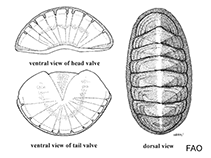Ischnochiton comptus (Gould, 1859)
Fancy chitonWarning: DOMDocument::load(): SSL operation failed with code 1. OpenSSL Error messages: error:140770FC:SSL routines:SSL23_GET_SERVER_HELLO:unknown protocol in C:\Apache24\htdocs\includes\SpeciesSummary.lib.php on line 1236
Warning: DOMDocument::load(): Failed to enable crypto in C:\Apache24\htdocs\includes\SpeciesSummary.lib.php on line 1236
Warning: DOMDocument::load(https://sealifebase.nrm.se/webservice/AquaMaps/getAMap.php?genus=Ischnochiton&species=comptus): failed to open stream: operation failed in C:\Apache24\htdocs\includes\SpeciesSummary.lib.php on line 1236
Warning: DOMDocument::load(): I/O warning : failed to load external entity "https://sealifebase.nrm.se/webservice/AquaMaps/getAMap.php?genus=Ischnochiton&species=comptus" in C:\Apache24\htdocs\includes\SpeciesSummary.lib.php on line 1236
Envoyez vos Photos
Images Google | No image available for this species;
drawing shows typical species in Ischnochitonidae.
Images Google | No image available for this species;
drawing shows typical species in Ischnochitonidae.
Classification / Names Common names | Synonyms | CoL | ITIS | WoRMS
| Chitonida | Ischnochitonidae
Environment: milieu / climate zone / depth range / distribution range Écologie
. Subtropical
Distribution Pays | Zones FAO | Écosystèmes | Occurrences | Introductions
Western Pacific: Japan, south to the Philippines.
Length at first maturity / Taille / Poids / Âge
Maturity: Lm ? range ? - ? cm Max length : 2.5 cm TL mâle / non sexé; (Ref. 283)
Description synthétique Morphologie
Valves broad; mostly light grayish brown; variously blotched with white, cream, pink, reddish chestnut or blackish brown; some specimens are olive colored mottled with white. Valve surface microgranulose, sculptured with numerous weak, glossy, radiating riblets. Girdle scaly and colored in alternating yellowish and grayish or brownish bands.
Found from intertidal to 50 m, on rocks and gravel (Ref. 75835). Also found under stones, just before Sargassum (Ref. 128661).
Life cycle and mating behavior Maturité | Reproduction | Frai | Œufs | Fécondité | Larves
Members of the class Polyplacophora are mostly gonochoric. Life cycle: Eggs hatch into lecitotrophic planktonic trocophore larvae (no veliger stage) which later metamorphose and settle on the bottom as young adults.
Référence principale
Références | Coordinateur | Collaborateurs
Burghardt, G. and L. Burghardt. 2006. (Ref. 283)
Statut dans la liste rouge de l'IUCN (Ref. 130435)
statut CITES (Ref. 108899)
Not Evaluated
CMS (Ref. 116361)
Not Evaluated
Menace pour l'homme
Harmless
Utilisations par l'homme
| FishSource |
Outils
Plus d'informations
Pays
Zones FAO
Écosystèmes
Occurrences
Introductions
Stocks
Écologie
Régime alimentaire
Éléments du régime alimentaire
Zones FAO
Écosystèmes
Occurrences
Introductions
Stocks
Écologie
Régime alimentaire
Éléments du régime alimentaire
Sources Internet
BHL | BOLD Systems | CISTI | DiscoverLife | FAO(Publication : search) | Fishipedia | GenBank (genome, nucleotide) | GloBI | Gomexsi | Google Books | Google Scholar | Google | PubMed | Arbre de Vie | Wikipedia (Go, chercher) | Zoological Record
Estimates based on models
Catégorie de prix
(Ref. 80766):
Unknown.



